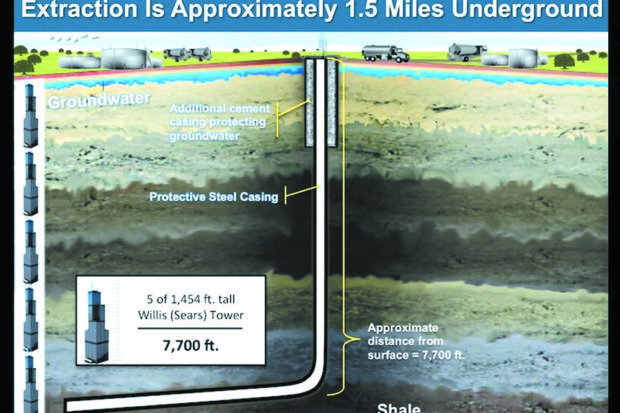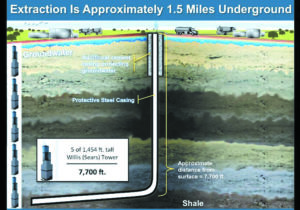
By Vic Bedoian

The State of California has released draft rules on the hydraulic fracturing process to produce oil and gas. The practice known as hydraulic fracturing, or fracking, injects a mix of water and chemicals under high pressure to extract fossil fuels from deep in rock formations. Fracking regulation was the focus of several unsuccessful bills in the state legislature last year.
In December, it took the U.S. Bureau of Land Management 10 minutes to auction 18,000 acres of public lands in the vast Monterey Shale formation along the Coast Range of Central California. Governor Jerry Brown’s administration has promoted shale-oil development in the state and has been under pressure from environmentalists to come up with basic oversight rules.
As California flirts with the lure of Black Gold, fault lines are developing between the economic benefits and environmental liabilities. The State Division of Oil, Gas and Geothermal Resources has responded with draft rules to oversee fracking. The proposed regulations would make companies disclose the chemicals used and the location of wells. Many of the chemicals are known carcinogens. The draft rules are considered a good beginning by some environmental advocates and lawmakers.
There is also fierce criticism of the rules for not being tough enough. Kassie Siegel is a climate specialist with the Center for Biological Diversity, a group that sued the state last year over the absence of fracking rules. She blasted the proposed rules: “The draft regulations provide almost no real protection for our air, our water or our climate. They won’t protect residents from increased air pollution which is certain to accompany oil and gas development and fracking. They don’t require collection even of the most basic data we would need on air quality and water quality. Baseline data in order to monitor to determine if damage was being done from fracking, and they keep the chemicals used in fracking shrouded in secrecy through the use of huge loopholes for so-called trade secrets.”
Siegel says that the rules dealing with public notification are inadequate. Oil and gas companies only need to give state regulators 10 days of notice, and regulators need only post notice on the Frac Focus Web site three days before fracking.
The petroleum industry sees the draft regulations in a positive light. Even though industry lobbyists say they favor some regulation, they opposed all the legislation that was proposed last year. Tupper Hull, representing the Western States Petroleum Association (WSPA), lauded the state for its effort creating the rulemaking process.
He praised the announcement, “We did appreciate the thoughtfulness that the Department has put into this process. We think they’ve created a very appropriate framework going forward. I’m sure other groups and certainly WSPA will be a part of that conversation. I think it’s also gratifying that the Division continues to acknowledge the important role hydraulic fracturing can play in California’s economic future.”
Noting the fracking-induced pollution problems that have plagued residents in other states, Siegel says the Center for Biological Diversity has a zero-tolerance policy on increased petroleum development in general and fracking in particular, “The problem is even a perfect regulatory system couldn’t eliminate the risks that fracking poses to our air, our water and our climate. That’s why we’re working for a ban on fracking in California. The Brown administration could and should scrap this extraordinarily weak proposal and replace it with a simple prohibition on fracking. If the administration won’t do that, then the Legislature should act.”
So far, fracking has been limited in the state, Hull says. WSPA members, who produce 80% of the state’s petroleum, were fracking at 628 wells in 2011, mostly in Kern County. Hull claims that the jury is still out on whether fracking in the Monterey Shale will be profitable for the industry, “This is still an area where exploration is taking place but it’s not clear whether or not this huge and centrally beneficial resource can be brought to consumers in California.”
The extensive shale formation development experienced in states like Pennsylvania and North Dakota is late in coming here. But the potential for 15 billion barrels of oil has the industry promoting California as the next big thing. Siegel wagers that where there’s a will, there’s a way, “What we’ve with these latest fracking methods is that the oil companies are out there every day experimenting on the best way to extract the oil and the gas, in California it’s mostly oil. And once they figure out the best way to exploit those fossil fuels you see a huge boom and you see areas transformed almost overnight.”
Over the next few weeks, the new fracking rules will be hammered out by state regulators and lawmakers along with an assortment of interested stakeholders. But those regulations will not put an end to the controversy surrounding the contentious technique and its impact. Critics of fracking in the Monterey Shale, from Kern County farmers to Bay Area climate change activists, are putting Jerry Brown’s administration on notice that they plan to resist the juggernaut of Black Gold.
*****
Vic Bedoian is an independent radio and print journalist working on environmental justice and natural resources issues in the San Joaquin Valley. Contact him at vicbedoian@gmail.com.
